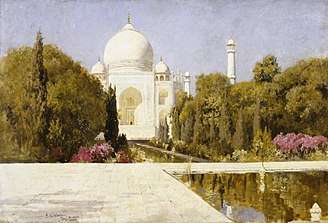Ustad Ahmad Lahori
Ustad Ahmad Lahori was an architect in present day India during Mughal Empire.[1][2] He said that he was the chief architect of the Taj Mahal in Agra, India, built between 1632 and 1648 during the ruling period of Mughal emperor Shah Jahan. Its architecture, being a combination of Persian and Mughal architectural styles, is widely praised around the world and Taj Mahal is considered to be one of the 'wonders of the world'.
Ahmad Lahori also known as Ustad Isa | |
|---|---|
| Died | Mughal India |
| Occupation | Architect |
Life

Shah Jahan's court histories emphasise his personal involvement in the construction and it is true that, more than any other Mughal emperor, he showed the greatest interest in building new magnificent buildings, holding daily meetings with his architects and supervisors. The court chronicler Lahori, writes that Shah Jahan would make "appropriate alterations to whatever the skilful architects had designed after considerable thought and would ask the architects competent questions."[3]
Lutfullah Muhandis, two architects are mentioned by name; Ustad Ahmad Lahori[4][5] and Mir Abd-ul Karim.[6] Ustad Ahmad Lahori had laid the foundations of the Red Fort at Delhi (built between 1638 and 1648). Mir Abd-ul Karim had been the favourite architect of the previous emperor Jahangir and is mentioned as a supervisor, together with Makramat Khan,[6] for the construction of the Taj Mahal.[7]
See also
Notes
- Hugh Honour, John Fleming (2005). A World History of Art. Laurence King Publishing. p. 541. ISBN 978-1856694513.
a Persian who later ....
CS1 maint: uses authors parameter (link) - Janin, Hunt (2006). The Pursuit of Learning in the Islamic World, 610-2003. p. 124. ISBN 978-0786429042. Retrieved 3 May 2016.
- Koch, p.89
- UNESCO advisory body evaluation, Ahmad Lahori, architect of the emperor, Retrieved 9 May 2016
- Begley and Desai (1989), p.65
- Asher, p.212
- Dunkeld, Malcolm (Ed) (June 2007). "Construction history society newsletter" (PDF). Chartered Institute of Building. Archived from the original (PDF) on 27 September 2007. Retrieved 23 July 2007.CS1 maint: extra text: authors list (link)
References
|